You are reading the older HTML site
Positive Feedback ISSUE 5
february/march 2003
manley labs
Impressions: The Snapper Monoblock Amp and Shrimp Preamp - Tasty Stuff!
by David W. Robinson
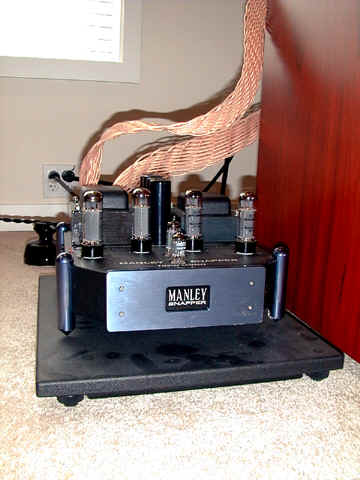
The Manley Snapper monoblock—cool!
(All photos and digital processing by Robinson, unless otherwise noted)
DAVID ROBINSON'S SYSTEM: LOUDSPEAKERS ELECTRONICS SOURCES CABLES ACCESSORIES
|
After All These Years...
You know, it's strange. In PF's "Ghost of Christmas Past" bin, the Manley name crops up from time to time.
Long-time Positive Feedback readers will remember when David Manley wrote several articles in which he jousted about push-pull vs. single-ended designs with Peter Qvortrup of Audio Note UK. Both wrote parallel articles, debating the issues pretty hotly. Quite the feisty series, for sure! (By the end of it, both men seemed to be a bit surprised by the fact that they had developed a certain grudging respect for each other, despite "agreeing to disagree.")
We've also done a couple of reviews of Manley amps... former Associate Editor Pat Hickman and current Associate Editor Stu McCreary have enthused over the performance of Manley kit 4-5 years ago.
There's more. In February of 1994 (just after the big quake... much damage!) I visited PF's Ray Chowkwanyun and Dave Glackin in Los Angeles. We had been invited by Ying Tan and Michael Hobson to sit in on a Classic Records mastering session with Bernie Grundman as he cut the lacquer for one of the first RCA Living Stereo reissues to vinyl, Gaite Parisienne, a session that we attended in conjunction with three writers from The Absolute Sound. A great time was had by all, of course... but just before I left, Ray, Dave and I were able to squeeze in a trip to the Manley Labs facility as it was at that time. David and EveAnna Manley were not there at the time, but we did get to see the production lines and a recording studio that was in the midst of construction. It was pretty impressive stuff…
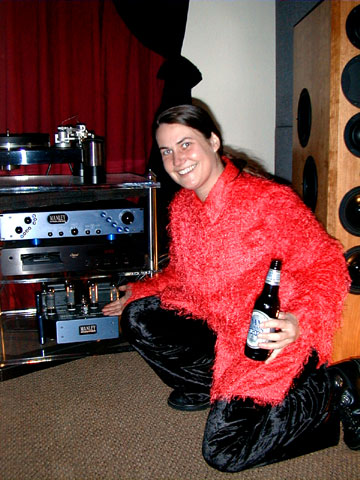
EveAnna Manley at CES 2003... coolest!
From time to time, I would see David Manley’s wife EveAnna Manley at CES or Stereophile shows, just in passing. She's a very cool person: energetic, enthusiastic about tubes, and passionate about the audio design work that Manley Labs was doing. It was always a lot of fun to see her; I enjoy talking with anyone in fine audio design who does great work and has a good time doing it—and that’s EveAnna!
From what I could tell under show conditions (which are always indifferent at best, and terrible at worst), the Manley gear that I heard sounded good.
And yet, with all these contacts over the years, I had never personally listened to Manley Labs components in my own listening system.
Tempus fugit
Well, time goes on, and things change. Nowadays, David Manley is no longer associated with Manley Laboratories; instead, it is now run by EveAnna. Under her leadership Manley Labs has prospered, with extensive new product design and production in both professional and fine audio applications. (For more information, see www.manleylabs.com/about99.html.) I wasn’t following what Manley Labs was doing, though... there are an awful lot of things going on in the world of fine audio, and it's hard to track all of the companies very closely.
What put Manley Labs back on the map for me was a conversation that I had with my old audiobud Chad Kassem of Acoustic Sounds and Analogue Productions. We were talking about the original production work that he had been doing with various blues artists (see Dave Glackin's excellent coverage of Chad's efforts at Blue Heaven Studio in Positive Feedback Online, Issue 1, www.positive-feedback.com/Issue1/bluesfestival.htm, and his photos in Issue 3 at www.positive-feedback.com/Issue3/blues02.htm) and in re-mastering and reissuing some terrific recordings on both vinyl and SACD. While we were talking about LPs and Acoustech, he suddenly asked me:
"Say, have you heard EveAnna’s new phono amp? The Steelhead?"
"No, I haven't... any good?" sez I."
"Man, it's good. You oughta' check with 'Vanna and see if you can get one to review."
One thing I can say about the Chadmeister: he's got a good ear for things vinyl. So, I decided that the time had come to contact EveAnna again...
Logistics... A-OK!
A few emails and a phone call, and EveAnna and I were cranking on this project. She was willing to send along a Steelhead as soon as she could catch up with the demand (that's always a good sign). In the meantime, I thought that maybe I could give some of her established reference pieces a go—was she willing?
Uh, no.
"Man, we've got lots of reviews for that! That's not our newest stuff!"
Like any good artist or designer, EveAnna was more interested in her latest work, and what was coming. So she put it to me: was I up for a listen to her cool new Shrimp preamp and Snapper monoblocks? They weren't as big and powerful as their older siblings, but she was sure that I would like the sound of the new designs.
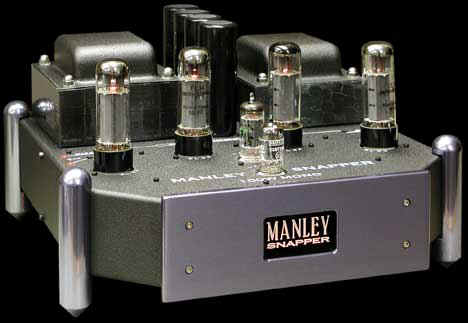
The Manley Snapper
(photo courtesy of Manley)
"They really rock!"
Hey, sure... why not?
Done deal.
The Shrimp and Snappers arrived a few weeks later in good shape. The packaging—something that I always pay attention to, for obvious reasons—was very solid box-within-a-box. Both the Shrimp and the Snappers are shipped with tubes installed, so packaging is even more important than usual. I particularly liked the use of large foam pads with cut-outs to protect the tubes in the Snappers... a great idea.
This meant that after I unpacked the Snappers, all I had to do was put on my cotton "tube glove," make sure that all the tubes were firmly seated in their sockets before powering up (something that I do with all tube gear, by the way... always be sure that your tubes take their seats before launch), and I was ready to go.
Component Description
The Snappers
First off, these are sharp looking little fishies! (Anyone who thinks that fine audio gear ought to look ugly, dark, dorkey, or otherwise grim really needs to get a clue here. Porsche clearly demonstrates that performance and looks are not antithetical... and there are some audio companies that could stand to learn a thing or two about this.) Congrats, EveAnna, on a good-looking design!
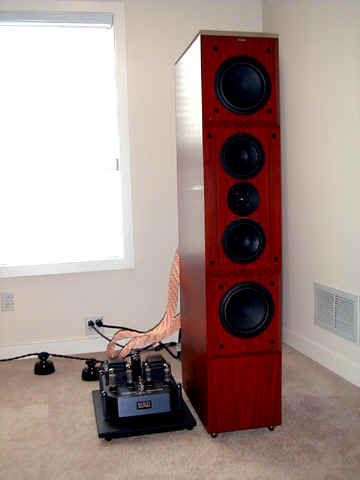
The Snapper swimming with the Nova Rendition II; the
speaker cable is the JENA Labs Pathfinder
On the technical side, the Snappers are an EL-34 ultralinear, fully balanced design, with a complement of 1 12AT7 input, 1 7044 driver, and 4 EL-34's outputs per monoblock. The Snapper is rated at 100WPC @ 10 Hz "all day long," and up to 110WPC @ 8 ohms from 15 Hz to 40 KHz, dropping to 100WPC @ 5 ohms—really pretty bodacious numbers. Manley Labs states that their new transformers are responsible for this excellent performance, and allow the amps to put out serious power at high bandwidth for long stretches of time. EveAnna really hit this point with me in one of our telephone conversations, noting that a lot of specifications claim great frequency responses for their amps, but do so only at relatively low power outputs.
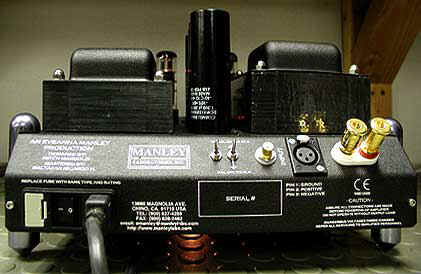
Snapper, rear view (photo courtesy of Manley)
Of particular interest to me is the fact that the Snapper is easily switchable from XLR to unbalanced modes, and this has been done without boging down the amp circuitry with a lot of extra components/transformers. Very clean. Toss two switches, and you’ve switched modes from XLR to unbalanced, or vice versa; the circuit is "self-balancing." Manley Labs notes that this is the first of their amps to do anything like this. You can even populate both inputs if you want to, and switch between them. (If you don’t use one, Manley Labs says the other can be used as a "poor man's mute." Good point... and handy to do while using the old DMM to adjust bias!) Me, I appreciated the flexibility in the listening room, since I have a tendency to try different preamps from time to time. It’s really helpful to be able to go from balanced to unbalanced quickly... and the Snappers made it easy.
Another handy-dandy is the fact that the bias testing points are easy to get to, as are the trim pots. Once the tubes had warmed up for a day or so, I was able to get in with my trusty-rusty digital multimeter and get the tubes fine-tuned very quickly. Also very pleasant was the soft-start circuitry in the Snappers... no wear and tear on the speakers while powering up.
So far, so good... time to see how the Snappers sounded.
The Sound
To get a feel for how the Snappers sounded, I left the Balanced Audio Technology VK-51SE, my current reference preamp in place. (A review of the BAT VK-51SE will be appearing in the spring of 2003.) I ran balanced out to the Snapper balanced inputs. The first speakers in place were my long-standing references, the Nova Rendition II's, whose sound I know very well. Interconnects were JENA Labs Twin shielded XLRs; speaker cables were the exceptional JENA Pathfinders; power cables to the amps were a pair of VansEvers Pandoras set to roughly the medium bridge position. The Snappers were placed on a pair of Townshend isolation stands to the inside of each of their speakers.
Later on, after I had a sense of the Snappers sound, the Nova Rendition II's were replaced by a pair of the utterly magnificent Kharma Grande Ceramiques (MUCH more on these incredible speakers in the near future), which were used to complete the review. More on that in a moment...
As usual, I gave the Snappers a run-in for a day or two with some SACDs, then followed the Manley Labs docs for adjusting the bias. Anyone comfortable with basic DMM operation can do this in just a few minutes. I then settled back to listen to how the Snappers sounded.
No surprise. Right out of the box, the Snappers were a bit congested and hazy, and somewhat two dimensional. It took a couple of days before they began to clear up, develop some clarity and warmth, and then bloom. Overall, it took between 100 and 125 hours before the Snappers really hit their stride... but then, they really hit it!
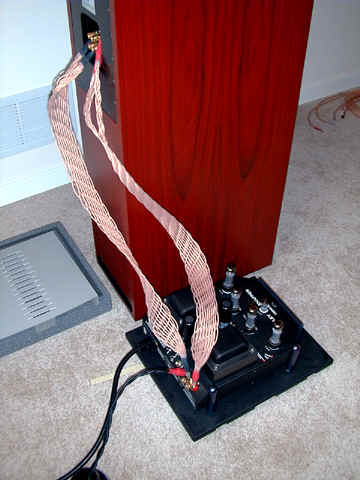
Rear view of the Snapper showing the cabling in balanced
mode
Whenever I review a component in my listening room, I try to come up with a single word to sum up the character of what I'm hearing. This is a practice that has served me well, by forcing me to concentrate on the essential character of what I'm hearing, measured against my experience in my listening room. This does not set aside my many comments on the overriding importance of synergy in audio systems; it simply means that, when evaluating a component in a known system, I try to pick out the essence of the component in the midst of it all.
In the case of the Snappers, after they were broken-in I thought, "These amps are really a kick! They really swing!" I don't think that the usual audiophile lexicon works here; "swing" summarizes the feeling that they gave me. I could break this down a bit, I suppose, as I sit here thinking about it.... The Snappers were agile and responsive, with a clean (though not bottomless) bass, a midrange that was very clear, and well extended high frequencies. There was no "tube tubbiness" (that old stereotype!) at all... but also no sense of ringing, smearing, or unclearness. These must be very good transformers, amigos.
The presentation of music was coherent and well integrated, top to bottom, with the Nova Rendition II’s. I was surprised at how well the Snappers did tonally; I hadn't been sure that smaller monoblocks would be able to drive larger speakers like the Renditions (nominal 4 ohm load, dipping to 3, 88 dB/Watt/meter efficiency) very well... but they didn’t seem to have any problems at all. No break-up, no sense of pooping out or clipping under any reasonable use... and one or two less reasonable ones! (The SACD of Spitball's Pop Condition remains one of the toughest of the acid tests for system performance... the Snappers did reach some limits there. Nothing gross, but you could tell that they were tapping out to try to handle some of the very deep/dynamic passages on that SACD. Most of you probably don’t go there, depending on your taste in music...)
I liked the soundstage presented by the Snappers; perhaps not as wide as the best that I’ve heard, but very good nonetheless. Depth was excellent, extending through my back wall on some of my best reference SACDs (e.g., any of the FIM's, Opus3’s, Hyperions, or Chad's Fantasy catalog reissues... the Creedence Clearwaters in particular rocked and rolled! And then there are the ABKCO SACDs of the Stones... just built for the Snappers... but I digress); imaging was adjudged to be very good, with precise placement of both layers and left/right locations. I note in passing that this is one of the great blessing of using reference quality SACDs for sources; they really do put the question to the rest of the system downstream, and allow us to use microphone feed or master tape quality sound to more carefully assess what a system is capable of doing right... or wrong.
The thing that stood out to me as I listened to the Snappers for several weeks continually was that they really had swing... they jumped! These quick little critters made music, and when they did so, they made you want to tap your toe and nod your head. I had a number of good friends drop by for listening sessions... some were audiophiles, and some were not. It didn't matter; all of them were mightily taken by the music coming out of the Snappers. One of them, a bass player for a local alternative group, said "Right on!" immediately after the music started to roll (some Stones and Creedence, to be specific), and got deeply into it. What a listening session that was!
In other words, the Snappers have a high thwack factor and real excellence in the "kick ass department." I'm really tempted to say that I found the Snappers to be incredibly musical, but some folks might interpret that as "oh, he means ‘euphonic,' which is a very bad thing." (In passing, I wonder how euphony, which in the Greek literally means "good sound," could have come to have such a negative connotation. The etymology militates against current usage. I reckon that, at some point, some reviewer somewhere this perversion of the term to be a useful way to "damn with faint praise." And now we seem to be stuck... )
Nevertheless, (look out!!) the Snappers were incredibly musical.
Another visitor was a very seasoned and experienced audiophile... his comment being simply, "That’s a really sweet amp!"
I agree.
The Kharma Grande Ceramique Arrives...
A few weeks later, good audiobuds Bill Parrish of GTT Audio (http://www.gttgroup.com/av.htm) and Jonathan Tinn delivered on a promise to send a pair of Kharma Grande Ceramique speakers for review. (My major review about these utterly remarkable loudspeakers will be appearing in Positive Feedback Online by late spring of 2003.) I was able to get a pair just in time to spend some time listening to them with the Snappers before returning the Snappers to Manley Labs.
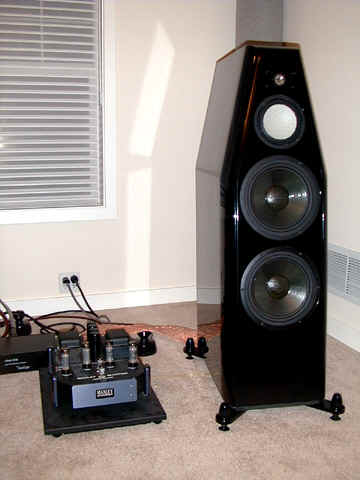
The Snapper drifts downstream with the Kharma Grande
Ceramique loudspeaker—yowzah!
Without blowing my still-developing review copy, let's just say that the Grande Ceramique's are bloody extraordinary transducers, costing more than twice what the Rendition II's do ($47,000 vs. about $22,000). They represent a different, slightly easier kind of load for the Snappers (93 dB/Watt/meter efficiency, nominal 4 ohms), but were obviously very revealing of any weaknesses in the upstream system. I was really curious to see how the Snappers would do in such august company.
No problemo, amigo! The sound was even better with the Kharmas than it had been with the Novas. While there was still not the very deepest bass that more bodacious amps might supply, the fact is that the Snappers did extremely well in every other department. As a matter of fact, that "thwack factor," the ability to jump and make music was more clearly evident with the Kharmas than it had been with the Novas... and the Novas are no slouches. Especially noteworthy was the unreal coherence and transparency, the utter ease and authority that the Grande Ceramiques brought to my listening experience. In tandem with such works of art, the Snappers showed that they were capable of fine levels of refinement and tonal excellence, as well as the ability to make you tap your toe.
When we hooked the Snappers up to the Kharmas, they were revealed to be even better than they had been before... a prime example of system synergy in action. You might not normally pair the Manley gear with Kharmas... but you sure could.
No surprise, then... it was therefore with a certain sadness that I sent the Snappers back to EveAnna and the good people at Manley Labs. These are amps with real verve and great personality... I'll miss 'em.
The Shrimp Preamp

A Shrimp! (photo courtesy of Manley)
I didn't get to spend as much time with the Shrimp as I did with the Snappers due to the amount of preamp traffic that was happening at that time. Nevertheless, I was really struck by this preamp that offers so much for the money. The Shrimp is a one of those products that doesn't try to bowl you over; it just gets on with the job.
The configuration is pretty straightforward: a pair of 12AT7’s, a pair of 7044’s. Short signal pathing... nothing fancy. Soft power-up, 'phile grade caps, and Noble pots for volume and balance... I do like the feel of these knobs. Dimensions of 19" x 11" x 3.5", and weighing in at between 10 and 15 pounds, this is one trim Shrimp! (He wonders: will EveAnna ever come up with a big brother reference preamp named the "Jumbo Prawn"? Stay tuned...)
There are five inputs on the input switching, plus volume, balance, mute, and power. An output for recording is provided, as well. The balance features center detent. I also note that the Shrimp is non-inverting, which is a logical plus when cabling your system. The overall look and feel is in line with Manley’s new look: quasi-retro, professional, and very cool!
A good point to note: the Shrimp did not take very long to break in. For the first day or two, it was a bit tight sounding, though surprisingly uncongested. After that, it just seemed to bloom quickly, and played like a champ.
The Sound of the Shrimp was very clean, very clear. I didn’t detect any overly warm signature, no was there any tubbiness. The dynamics were there during SACD playback, something that I was curious about before listening, though not at the same level as some of the "cost no object" preamps that I have listened to. No shock there; mega-dynamics require expensive components and beefy power reserves that require some serious bucks. Nevertheless, the Shrimp was able to do some serious reproduction with both classical and rock SACDs. Micro-dynamics were good, as well; glissando and pizzicato were rendered very acceptably.
Soundstaging and imaging were also adjudged to be good. With both the Nova Rendition II's and the Kharma's, the Shrimp showed itself capable of extending left/right to acceptable levels. Soundstage depth was quite good with reference SACDs; I was quite satisfied with the depth of what I was hearing. Again, I have heard better preamps in this regard, but you'll spend $5000–$10,000 to enjoy them.
Particularly good aspects of the Shrimp's playback was to be found in the sense of drive, of punch, and the pleasing rhythm that this preamp has in tandem with the Snappers. As I listened to the Shrimp/Snappers combo, I was struck by how much I was getting into the music, and how tempted I was to dance! This is similar to the sort of feeling I get when listening to another great tube preamp, deHavilland's UltraVerve... both of these preamps have an awful lot of groove hidden under the hood! And knowing EveAnna, this is exactly what she and her gifted design crew are shooting for.
You know: "It don't mean a thing, if it ain't got that swing!"
The Shrimp and the Snappers swing.
Conclusion
The Shrimp preamp is a terrific little preamp: a distinctive look, but a clear, clean, neutral presentation. No bad habits... no noise... loved playing SACDs all day long... and a relatively quick break in. For a preamp that was fairly light in weight, the Shrimp delivered a musically satisfying experience that was surprising at this price point. I wouldn't have been surprised if the Shrimp had sported a price of $2995; at $1880, it's a real honey!
The design team of EveAnna, Mitch Margolis and Baltazar Hernandez has really done a number here... at anything like their price point, the Snappers are truly exceptional amps. The consensus of the PF Online Editorial Gang, River City Branch, was that the Snappers were sharp looking, great sounding, a pile of fun, and a great deal at the price.
If you're looking for a flexible, powerful monoblock tube pair with a matching preamp that really swings, then your search may be over—you really should swim upstream and check out the Shrimp and Snappers!
The Manley Labs Shrimp preamp and Snapper amps therefore rate a Ye Olde Editor's "highly recommended."
Retail:
Snapper monoblocks: $4250 per pair; Shrimp Preamp: $1880.
As far as we know, shipping/handling is additional, but check with Manley Labs on that
one.
Manley
Laboratories
13880 Magnolia Avenue
Chino, CA 91710
TEL: 909-627-4256
web address: www.manleylabs.com
email address: [email protected]
